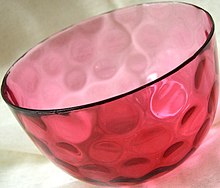Cranberry glass

Cranberry glass (or Gold Ruby glass as it is known in Europe) is a red glass made by adding gold(III) chloride to the molten glass. Tin, in the form of stannic chloride, is sometimes added in tiny amounts as a reducing agent. The glass is used primarily in expensive decorations.
Cranberry glass is made in craft production rather than in large quantities, due to the high cost of the gold and the delicate mixing process required. The gold chloride is made by dissolving gold in a solution of nitric acid and hydrochloric acid (aqua regia), producing a colloid. The glass is typically hand blown or molded. The finished, hardened glass is a type of colloid, a solid phase (gold) dispersed inside another solid phase (glass).
The origins of cranberry glass making are murky. Some historians feel a form of this glass was first made in the late Roman Empire. The craft was then lost and rediscovered in the 17th Century by either Johann Knuckel in Bohemia or by the Florentine glassmaker Antonio Neri in Italy. But neither of them knew the mechanism which yielded the colour. The colloid chemist and later Nobel prize winner of 1925 Richard Adolf Zsigmondy was able to understand and explain that small colloid gold particles are responsible for the red colour.
The most famous period of cranberry glass production was in 19th Century Britain during the Victorian Era.
Legend holds that cranberry glass was first discovered when a noble tossed a gold coin into a mixture of molten glass. This legend is almost certainly not true, as the gold must be dissolved in aqua regia (a mixture of hydrochloric and nitric acids) before being added to the molten glass.
Cranberry glass creations were most popular as a table display, often holding confectioneriess or flowers. Cranberry glass was also frequently used for wine glasses, decanters, and fingerbowls. Cranberry glass was also well-known for its use in "Mary Gregory" glass. This glass had a white enamel fired onto the glass in a design, usually of romantic variety.
